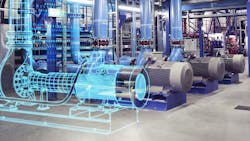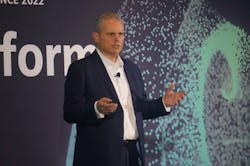Digital twin technology has been around for several years now and we’re beginning to see its application outside of the large industrial companies that initially championed its development for complex engineering and manufacturing purposes. As with any newer technology, however, a lack of broad understanding can hinder its wider adoption.
Muddying the waters around digital twin technology are the varying definitions of it. Most all definitions agree that a digital twin is a digital rendering of all the components in a machine, device, or component connected to data inputs from the physical device the digital twin represents. This definition can extend to include all equipment on a production line or the plant floor. The definitions can diverge, however, in terms of how to apply the technology and the types of insights that can be delivered.
At its recent media and analyst event in Detroit, Siemens Digital Industries Software sought to clarify what it means when using the term digital twin. To help explain the broad meaning and application of digital twin technology, Siemens refers to the “comprehensive digital twin” and the “executable digital twin.”
Comprehensive and executable
Ian McGann, director of Siemens Innovation Office, said Siemens view of the comprehensive digital twin is that it’s “a precise virtual representation of a physical object, including its mechanical, electrical, and configuration management. This one digital twin evolves across its lifecycle with numerous models used to capture different aspects of the object’s physical behavior.”
“Simulation [data] doesn’t normally flow across design, manufacturing, and service,” he said. “Siemens goal is to do that by using the initial models created in the design stage.” He explained that, by starting with the digital twin at the design stage, the digital twin can be more easily real-time enabled and created to be self-adapting and calibrating with no additional solvers required.
This kind of digital twin process starts with a full 3D model created at the design stage that is then “exported and containerized as an executable digital twin (xDT) that can be used across the design, manufacturing, and service stages,” McGann said. “This allows developers to see the stresses and strains on the model as it’s tested before bringing it to the shop floor. Once on the shop floor, we use an industrial PC and sensors to run the xDT on the physical model.”
According to Benjamin Lee, a simulation expert in Siemens research, xDTs are “self-contained, easily adaptable, and reusable simulation systems which keep their complicated mathematical inner life out of sight. When we supply our customers with an xDT, they get a model that meets their requirements for speed and accuracy; and it comes with an integrated simulation environment. They can use the xDT directly and adapt it with no need for expert mathematical know-how.”
McGann added that Siemens technology enables digital twin insights to be accessed by building an app with Mendix to see all digital twin objects individually or as a group using their data from Mindpshere. In TeamCenter, users can get a detailed overview of the asset and all its components.
Shifting left
A key aspect of successful digital twin adoption and application requires a “shift to the left” in thinking, according to Siemens. By this, Siemens means users need to think more holistically about the product, machine, or process to be managed by the digital twin in the early design stage (with the design stage at the left—or beginning stage—of the product lifecycle).
This shift to the left is not just a tactic for large manufacturers. Tutt said small companies and startups are looking more closely at how customers use their products so they can design them for multiple uses. This is increasingly important now as there’s “so much pressure to get a product to market done right [the first time], so as not to miss the cycle,” Tutt said.
About the Author
David Greenfield, editor in chief
Editor in Chief

Leaders relevant to this article:


